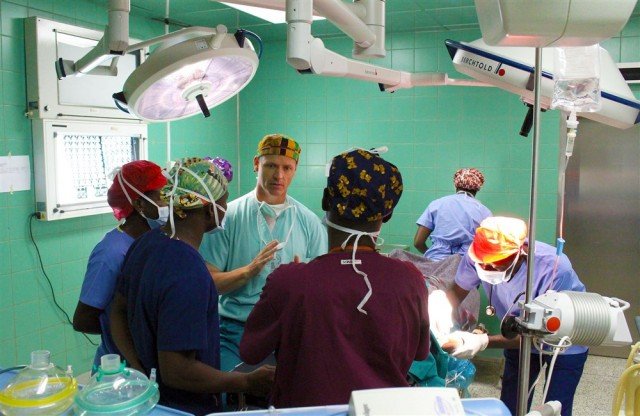
By Capt. Charles An
U.S. Army Africa
“Hey! I know you,” said the American to the Ghanaian in the hallway of the 37th Military Hospital located in Accra, Ghana.
U.S. Army Staff Sgt. Adrian Elisondo, a U.S. Army operating room specialist, recognized Chief Warrant Officer 2 Godwin Tornyevah from training in 2003 at Fort Sam Houston in San Antonio, Texas. Tornyevah was a Ghana exchange student while Elisondo was attending U.S. Army Advanced Individual Training.
Elisondo, of the U.S. Army’s 212th Combat Support Hospital, 30th Medical Brigade, Sembach, Germany, was in Ghana with eight other 212th CSH personnel, as well as the Army Reserve’s 7th Civil Support Command and the 3rd Medical Command Deployment Support, all taking part in a medical readiness training exercise known as MEDRETE 15-2.
The exercise allowed the U.S. soldiers to work and share medical procedures and best practices with their Ghanaian counterparts.
“Our expectations have been met because they have actually helped us doing so many things,” said Ghanaian Lt. Cmdr. Ruby Elikem Amegavluie, a 37th Military Hospital critical care nurse.
“I’ve learned how to work fast with patients, going around making sure things are well done with patients. That’s what I’ve picked up from the U.S. medical team,” Dr. Laurencia Tettey, an emergency room physician said.
“The Americans have made me a catalyst for change and that’s what I’m going to do when they are gone,” said Ghanian Sgt. Jeffrey Djornobua Obutey, an ER orderly at the 37th Military Hospital.
The U.S. medical team learned from their Ghanaian counterparts as well. Although they routinely use different equipment, the team discovered many procedural similarities.
“We’ve agreed the theories are all the same,” said U.S. Army Capt. Conoly Sullivan, a 212th CSH intensive care unit nurse. “We’re all taught the same biology, pathophysiology. We all treat our patients the same way. There are just a few differences in the tools.”
Sullivan worked with Amegavluie and her team during the exercise and learned firsthand how the Ghanaians conduct patient care.
Instead of using a central venous pressure device to measure patient vitals, she learned how to get the measurements manually, said Sullivan.
“For instance, if our monitors crash I wouldn’t know how to measure it,” said Sullivan. “By Ruby teaching me this, you can still get the information.” The technique is known as manual clinical practice protocols.
In some cases understanding patients and their needs was much simpler than running tests.
“You really have to rely on the family and the patient to give you a good history so you can get to the bottom of what’s going on,” said 212th CSH’s Sgt. Brittany Pineda, an ER medic.
“You have to go more off of what you can see from the patient versus using all these tests,” said Pineda.
The partnership between medical personnel of both nations allowed an opportunity to strengthen existing relationships and connect with Ghanaian patients.
“It’s really nice to talk to the family and learn their ways,” said Pineda. “When you see family members walking through the hospital, and they stop and thank you, it’s huge.”
The U.S. medical personnel arrived in early July and worked at the hospital for more than a month. U.S. and Ghanaian medical personnel expressed gratitude for the opportunity to have worked as partners as they reached the end of the exercise and the closing ceremony on Aug. 7.
“It has been an amazing experience. I would like to see them all often because it has done a lot in this operating room,” said Yaa Ntiriwaa Ofori, a 37th Military Hospital operating room nurse.
